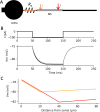Theory of axo-axonic inhibition
- PMID: 40258075
- PMCID: PMC12052214
- DOI: 10.1371/journal.pcbi.1013047
Theory of axo-axonic inhibition
Abstract
The axon initial segment of principal cells of the cortex and hippocampus is contacted by GABAergic interneurons called chandelier cells. The anatomy, as well as alterations in neurological diseases such as epilepsy, suggest that chandelier cells exert an important inhibitory control on action potential initiation. However, their functional role remains unclear, including whether their effect is indeed inhibitory or excitatory. One reason is that there is a relative gap in electrophysiological theory about the electrical effect of axo-axonic synapses. This contribution uses resistive coupling theory, a simplification of cable theory based on the observation that the small initial segment is resistively coupled to the large cell body acting as a current sink, to fill this gap. The main theoretical finding is that a synaptic input at the proximal axon shifts the action potential threshold by an amount equal to the product of synaptic conductance, driving force at threshold, and axial axonal resistance between the soma and either the synapse or of the middle of the initial segment, whichever is closer. The theory produces quantitative estimates useful to interpret experimental observations, and supports the idea that axo-axonic cells can potentially exert powerful inhibitory control on action potential initiation.
Copyright: © 2025 Romain Brette. This is an open access article distributed under the terms of the Creative Commons Attribution License, which permits unrestricted use, distribution, and reproduction in any medium, provided the original author and source are credited.
Conflict of interest statement
The author has declared that no competing interests exist.
Figures





Similar articles
-
Specific and comprehensive genetic targeting reveals brain-wide distribution and synaptic input patterns of GABAergic axo-axonic interneurons.Elife. 2024 Jul 16;13:RP93481. doi: 10.7554/eLife.93481. Elife. 2024. PMID: 39012795 Free PMC article.
-
Lighting the chandelier: new vistas for axo-axonic cells.Trends Neurosci. 2005 Jun;28(6):310-6. doi: 10.1016/j.tins.2005.04.004. Trends Neurosci. 2005. PMID: 15927687 Review.
-
Activity-Dependent Plasticity of Axo-axonic Synapses at the Axon Initial Segment.Neuron. 2020 Apr 22;106(2):265-276.e6. doi: 10.1016/j.neuron.2020.01.037. Epub 2020 Feb 27. Neuron. 2020. PMID: 32109363 Free PMC article.
-
Strategically positioned inhibitory synapses of axo-axonic cells potently control principal neuron spiking in the basolateral amygdala.J Neurosci. 2014 Dec 3;34(49):16194-206. doi: 10.1523/JNEUROSCI.2232-14.2014. J Neurosci. 2014. PMID: 25471561 Free PMC article.
-
Flexible processing of sensory information induced by axo-axonic synapses on afferent fibers.J Physiol Paris. 1999 Sep-Oct;93(4):369-77. doi: 10.1016/s0928-4257(00)80064-9. J Physiol Paris. 1999. PMID: 10574125 Review.
References
MeSH terms
LinkOut - more resources
Full Text Sources
Miscellaneous

